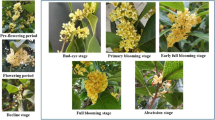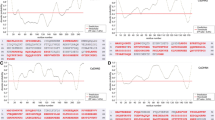Abstract
Based on the sequence of an expressed sequence tag, the full-length cDNA of 1,008 nucleotides was cloned from Ammopiptanthus mongolicus by rapid amplification of cDNA ends. It was designated as AmDHN, encoding a protein of 183 amino acids. The calculated molecular weight of the AmDHN protein is 18.4 k Da, and theoretical isoelectric point is 5.78. The AmDHN localized in nucleus. Under normal growth conditions, differential expression of AmDHN exhibited that the expression was the highest in seeds and the lowest in flowers. AmDHN could be induced by NaCl, PEG6000, ABA and drought treatments. Salt and drought resistances of transgenic plants with overexpression of AmDHN are improved. Taken together, these results demonstrated that AmDHN could regulate the expression of abiotic-responsive genes and plays important roles in modulating the tolerance of plants to abiotic stresses.









Similar content being viewed by others
Abbreviations
- ABA:
-
Abscisic acid
- CDS:
-
Coding domain sequence
- GFP:
-
Green fluorescent protein
- RACE:
-
Rapid amplification of cDNA ends
- RT-PCR:
-
Reverse transcriptase polymerase chain reaction
- SSH:
-
Suppression subtraction hybridization
- MW:
-
Molecular weight
References
Araus JL, Slafer GA, Reynolds MP, Royo C (2002) Plant breeding and drought in C3 cereals: what should we breed for? Ann Bot 89(7):925–940. doi:10.1093/aob/mcf049
Boyer JS (1982) Plant productivity and environment. Science 218(4571):443–448. doi:10.1126/science.218.4571.443
Chao Y, Kang J, Sun Y, Yang Q et al (2009) Molecular cloning and characterization of a novel gene encoding zinc finger protein from Medicago sativa L. Mol Biol Rep 36(8):2315–2321. doi:10.1007/s11033-009-9450-5
Zhang X, Ju HW, Chung MS, Huang P et al (2011) The R–R-type MYB-like transcription factor, AtMYBL, is involved in promoting leaf senescence and modulates an abiotic stress response in Arabidopsis. Plant Cell Physiol 52(1):138–148. doi:10.1093/pcp/pcq180
Kasuga M, Liu Q, Miura S et al (1999) Improving plant drought, salt, and freezing tolerance by gene transfer of a single stress-inducible transcription factor. Nat Biotechnol 17(3):287–291. doi:10.1002/9780470515778.ch13
Close TJ (1996) Dehydrins: emergence of a biochemical role of a family of plant dehydration proteins. Physiol Plantarum 97(4):795–803. doi:10.1111/j.1399-3054.1996.tb00546.x
Close TJ (1997) Dehydrins: a commonalty in the response of plants to dehydration and low temperature. Physiol Plantarum 100(2):291–296. doi:10.1111/j.1399-3054.1997.tb04785.x
Bray EA (1993) Molecular responses to water deficit. Plant Physiol 103(4):1035–1040
Koag MC, Fenton RD, Wilkens S, Timothy JC et al (2003) The binding of maize DHN1 to lipid vesicles. gain of structure and lipid specificity. Plant Physiol 131(1):309–316. doi:10.1104/pp.011171
Xu S, An L, Feng H, Wang X, Li X et al (2002) The seasonal effects of water stress on Ammopiptanthus mongolicus in a desert environment. J Arid Environ 51(3):437–447. doi:10.1006/jare.2001.0949
Clough SJ, Bent AF (1998) Floral dip: a simplified method for agrobacterium-mediated transformation of Arabidopsis thaliana. Plant J 16(6):735–743. doi:10.1046/j.1365-313x.1998.00343.x
Parmentier-Line CM, Panta GR, Rowland LJ (2002) Changes in dehydrin expression associated with cold, ABA and PEG treatments in blueberry cell cultures. Plant Sci 162(2):273–282. doi:10.1016/S0168-9452(01)00563-5
Giordani T, Natali L, D’Ercole A, Pugliesiet C, Fambrini M, Vernieri P et al (1999) Expression of a dehydrin gene during embryo development and drought stress in ABA-deficient mutants of sunflower (Helianthus annuus L.). Plant Mol Bio 39(4):739–748. doi:10.1023/A:1006194720022
Han B, Kermode AR (1996) Dehydrin-like proteins in castor bean seeds and seedlings are differentially produced in response to ABA and water-deficit-related stresses. J Exp Bot 47(7):933. doi:10.1093/jxb/47.7.933
Borovskii GB, Stupnikova IV, Antipina AI, Vladimirova SV, Voinikov VK (2002) Accumulation of dehydrin-like proteins in the mitochondria of cereals in response to cold, freezing, drought and ABA treatment. BMC Plant Biol 2(1):5. doi:10.1186/1471-2229-2-5
Mundy J, Chua NH (1998) Abscisic acid and water-stress induce the expression of a novel rice gene. EMBO J 7(8):2279–2286
Brini F, Hanin M, Lumbreras V, Amara I, Khoudi H, Hassairi A, Pagès M, Masmoudi K et al (2007) Overexpression of wheat dehydrin DHN-5 enhances tolerance to salt and osmotic stress in Arabidopsis thaliana. Plant Cell Rep 26(11):2017–2026. doi:10.1007/s00299-007-0412-x
Danyluk J, Perron A, Houde M, Limin A, Fowler B, Benhamou N, Sarhan F et al (1998) Accumulation of an acidic dehydrin in the vicinity of the plasma membrane during cold acclimation of wheat. Plant Cell 10(4):623–638. doi:10.1105/tpc.10.4.623
Zhu B, Choi DW, Fenton R, Close TJ (2000) Expression of the barley dehydrin multigene family and the development of freezing tolerance. Mol Gen Genet 264(1):145–153. doi:10.1007/s004380000299
Ohno R, Takumi S, Nakamura C (2003) Kinetics of transcript and protein accumulation of a low-molecular-weight wheat LEA D-11 dehydrin in response to low temperature. J Plant Physiol 160(2):193–200. doi:10.1078/0176-1617-00925
Caruso A, Morabito D, Delmotte F, Kahlem G, Carpin S (2002) Dehydrin induction during drought and osmotic stress in populus. Plant Physiol Bioch 40(12):1033–1042. doi:10.1016/S0981-9428(02)01468-7
Shekhawat UK, Srinivas L, Ganapathi TR (2011) MusaDHN-1, a novel multiple stress-inducible SK(3)-type dehydrin gene, contributes affirmatively to drought- and salt-stress tolerance in banana. Planta 234(5):915–932. doi:10.1007/s00425-011-1455-3
Godoy JA, Lunar R, Torres-Schumann S, Moreno J, Rodrigo RM, Pintor-Toro JA (1994) Expression, tissue distribution and subcellular localization of dehydrin TAS14 in salt-stressed tomato plants. Plant Mol Biol 26(6):1921–1934. doi:10.1007/BF00019503
Saavedra L, Svensson J, Carballo V, Izmendi D, Welin B, Vidal S (2006) A dehydrin gene in Physcomitrella patens is required for salt and osmotic stress tolerance. Plant J 45(2):237–249. doi:10.1111/j.1365-313X.2005.02603.x
Cellier F, Conejero G, Breitler JC, Casse F (1998) Molecular and physiological responses to water deficit in drought-tolerant and drought-sensitive lines of sunflower. Accumulation of dehydrin transcripts correlates with tolerance. Plant Physiol 116(1):319–328. doi:10.1104/pp.116.1.319
Cheng Z, Targolli J, Huang X, Wu R (2002) Wheat LEA genes, PMA80 and PMA1959, enhance dehydration tolerance of transgenic rice (Oryza sativa L.). Mol Breeding 10(1):71–82. doi:10.1023/A:1020329401191
Xu D, Duan X, Wang B, Hong B, Ho THD, Wu R (1996) Expression of a late embryogenesis abundant protein gene, HVA1, from barley confers tolerance to water deficit and salt stress in transgenic rice. Plant Physiol 110(1):249–257. doi:10.1104/pp.110.1.249
Lee SC, Lee MY, Kim SJ, Jun SH, An G, Kim SR (2005) Characterization of an abiotic stress-inducible dehydrin gene, OsDhn1, in rice (Oryza sativa L.). Mol Cells 19(2):212–218
Acknowledgments
We thank Dr. Yuehui Chao for advices and helps. This work is supported by the Scientific and technological innovation projects in Inner Mongolia (2011-CXJJM01) and Industrial system of national grass (CARS-35).
Author information
Authors and Affiliations
Corresponding author
Rights and permissions
About this article
Cite this article
Sun, J., Nie, L., Sun, G. et al. Cloning and characterization of dehydrin gene from Ammopiptanthus mongolicus . Mol Biol Rep 40, 2281–2291 (2013). https://doi.org/10.1007/s11033-012-2291-7
Received:
Accepted:
Published:
Issue Date:
DOI: https://doi.org/10.1007/s11033-012-2291-7




